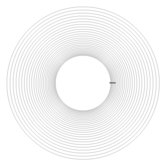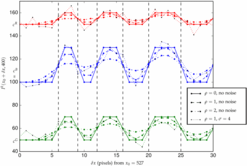Aim
The following dataset of synthetic images is intended to assess colour edge detection schemes.
Image construction
The synthetic true edge map (see Fig. 1(a)) is of 800×800 pixels. From the innermost circle (of 139 pixel diameter), the 27 concentric circle diameters increase so that the distance between two successive circles along the horizontal diameter ranges from 3 to 15 pixels with a step of 1 pixel.
The synthetic colour image I0 is built by using two consecutive circles as the edges of a colour ring. The innermost circle is filled with a given colour c, from which colours of successive rings alternate (see Fig. 1(b)). The first two rings (of the same width) are filled with colours c+δc and c, the following two rings (of the same increased width) are again filled with colours c+δc and c, and so on. The colour of edge pixels that separate two consecutive rings is set to c + δc/2.
Two extra parameters are the radius ρ (in pixels) of the Gaussian blur applied to each channel of I0 to tune transition width, and the level σ of the noise applied to the three blurred channels. Each blurred channel is corrupted by a zero-mean Gaussian noise whose standard deviation σk=σ×Ek / ( (ER+EG+EB) / 3 ) is proportional to the global noise level σ and to the energy (mean value) Ek of each channel of I0. Figure (c) displays the colour component profiles across innermost rings for different values of ρ and σ parameters.
Figure 1: Synthetic test image. Fig. (c) shows the colour component profiles and edge locations (dotted vertical lines) over the 31 row pixels shown as black lines on (a) and (b), for different blur radii and noise levels. The solid line profiles (ρ=0, no noise) correspond to image (b).
Download
The dataset is available for download here (462MB).
It contains the true edge map and the 486 images built with the following parameter values:
- c∈{(100,150,50), (150,50,100)}
- δc∈{(10,10,10), (10,20,10), (10,30,10), (20,10,20), (20,20,20), (20,30,20), (30,10,30), (30,20,30), (30,30,30)}
Note that δcR=δcB because we sample I0 according to the Bayer CFA in which R and B play a similar role. - ρ∈{0,1,2}
- σ∈{0,1,2,3,4,5,6,7,8}


